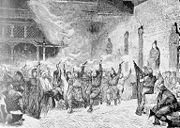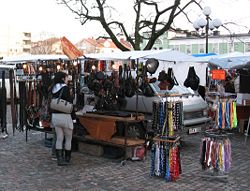
Dísablót
Encyclopedia


Blót
The blót was Norse pagan sacrifice to the Norse gods and the spirits of the land. The sacrifice often took the form of a sacramental meal or feast. Related religious practices were performed by other Germanic peoples, such as the pagan Anglo-Saxons...
(sacrificial holiday) which was held in honour of the female spirits or deities called dísir
Dísir
In Norse mythology, a dís is a ghost, spirit or deity associated with fate who can be both benevolent and antagonistic towards mortal people. Dísir may act as protective spirits of Norse clans...
(they include the Norns and the Valkyrie
Valkyrie
In Norse mythology, a valkyrie is one of a host of female figures who decides who dies in battle. Selecting among half of those who die in battle , the valkyries bring their chosen to the afterlife hall of the slain, Valhalla, ruled over by the god Odin...
s), from pre-historic times until Christianization in Scandinavia
Scandinavia
Scandinavia is a cultural, historical and ethno-linguistic region in northern Europe that includes the three kingdoms of Denmark, Norway and Sweden, characterized by their common ethno-cultural heritage and language. Modern Norway and Sweden proper are situated on the Scandinavian Peninsula,...
. Its purpose was to enhance the coming harvest. It is mentioned in Hervarar saga
Hervarar saga
Hervarar saga ok Heiðreks is a legendary saga from the 13th century combining matter from several older sagas. It is a valuable saga for several different reasons beside its literary qualities. It contains traditions of wars between Goths and Huns, from the 4th century, and the last part is used as...
, Víga-Glúms saga
Víga-Glúms saga
Víga-Glúms saga is one of the Icelanders' sagas. It tells of a chieftain who kills several people and tries to cover his guilt. It is believed to have been written in the 13th century.-External links:****...
, Egils saga
Egils saga
Egils saga is an epic Icelandic saga. The oldest transcript dates back to 1240 AD. The saga is centered on the life of Egill Skallagrímsson, an Icelandic farmer, viking and skald...
and the Heimskringla
Heimskringla
Heimskringla is the best known of the Old Norse kings' sagas. It was written in Old Norse in Iceland by the poet and historian Snorri Sturluson ca. 1230...
. The celebration still lives on in the form of an annual fair called the Disting
Disting
The Disting is an annual market which is held in Uppsala, Sweden, since pre-historic times. The name originally referred to the great assembly called the Thing of all Swedes, and it is derived from the fact that both the market and the thing were held in conjunction with the Dísablót, the great...
in Uppsala
Uppsala
- Economy :Today Uppsala is well established in medical research and recognized for its leading position in biotechnology.*Abbott Medical Optics *GE Healthcare*Pfizer *Phadia, an offshoot of Pharmacia*Fresenius*Q-Med...
, Sweden
Sweden
Sweden , officially the Kingdom of Sweden , is a Nordic country on the Scandinavian Peninsula in Northern Europe. Sweden borders with Norway and Finland and is connected to Denmark by a bridge-tunnel across the Öresund....
.
The Dísablót appears to have been held during Winter Nights
Winter Nights
Winter Nights or Old Norse Vetrnætr was a Norse winter festival that was initially celebrated in pre-Christian Scandinavia. It was said by Snorri Sturluson that Winter Nights is one of the three most important festivals. This festival also marks the end of the summer and start of the winter meaning...
, or at the vernal equinox. In one version of Hervarar saga, there is a description of how the sacrifice was performed. Alfhildr, the daughter of king Alfr of Alfheim
Álfheim
Alfheim is one of the Nine Worlds and home of the Light Elves in Norse mythology and appears also in Anglo-Scottish ballads under the form Elfhame as a fairyland, sometimes modernized as Elfland .-In Old Norse texts:Álfheim as an abode of the Elves is mentioned only twice in Old Norse texts.The...
, was kidnapped by Starkad
Starkad
Starkad, Old Norse: Starkaðr or Störkuðr, Latin: Starcaterus, and during the late Middle Ages, also known as Starkodder, was a legendary hero in Norse mythology....
Aludreng while she was reddening a horgr
Hörgr
A hörgr or hearg was a type of religious building or altar possibly consisting of a heap of stones, used in Norse paganism...
with blood.
This suggests that the rite was performed by women, especially in light of what is generally believed to be their nearly exclusive role as priestesses of the pagan Germanic religion. However, according to the Ynglinga saga
Ynglinga saga
Ynglinga saga is a legendary saga, originally written in Old Norse by the Icelandic poet Snorri Sturluson about 1225. It was first translated into English and published in 1844....
part of the Heimskringla, the king of Sweden performed the rites, which was in accordance with his role as high priest
Gothi
A goði or gothi is the Old Norse term for a priest and chieftain. Gyðja signifies a priestess.The name appears in Wulfila's Gothic language translation of the bible as gudja for "priest", but in Old Norse it is only the feminine form gyðja that perfectly corresponds to the Gothic form...
of the Temple at Uppsala
Temple at Uppsala
The Temple at Uppsala was a religious center in Norse paganism once located at what is now Gamla Uppsala , Sweden attested in Adam of Bremen's 11th century work Gesta Hammaburgensis ecclesiae pontificum and in Heimskringla, written by Snorri Sturluson in the 13th century...
. The mention of the Dísablót concerns the death of king Eadgils
Eadgils
Eadgils, Adils, Aðils, Adillus, Aðísl at Uppsölum, Athisl, Athislus or Adhel was a semi-legendary king of Sweden, who is estimated to have lived during the 6th century....
(Aðils, Adils) who died from falling off his horse while riding around the shrine:
In Sweden, the Dísablót was of central political and social importance. The festivities were held at the end of February or early March at Gamla Uppsala
Gamla Uppsala
Gamla Uppsala is a parish and a village outside Uppsala in Sweden. It had 16,231 inhabitants in 1991.As early as the 3rd century AD and the 4th century AD and onwards, it was an important religious, economic and political centre...
. It was held in conjunction with the great fair Disting
Disting
The Disting is an annual market which is held in Uppsala, Sweden, since pre-historic times. The name originally referred to the great assembly called the Thing of all Swedes, and it is derived from the fact that both the market and the thing were held in conjunction with the Dísablót, the great...
and the great popular assembly called the Thing of all Swedes
Thing of all Swedes
The Thing of all Swedes was the governing assembly held from pre-historic times to the Middle Ages at Gamla Uppsala, Sweden, occurring at the end of February or early March in conjunction with a great fair and a pagan celebration called Dísablót...
.
The Iceland
Iceland
Iceland , described as the Republic of Iceland, is a Nordic and European island country in the North Atlantic Ocean, on the Mid-Atlantic Ridge. Iceland also refers to the main island of the country, which contains almost all the population and almost all the land area. The country has a population...
ic historian Snorri Sturlusson, who was well-informed of Swedish matters and visited the country in 1219, explained in the Heimskringla
Heimskringla
Heimskringla is the best known of the Old Norse kings' sagas. It was written in Old Norse in Iceland by the poet and historian Snorri Sturluson ca. 1230...
(1225):
The shrine where the Dísir were worshiped was called dísarsalr and this building is mentioned in the Ynglinga saga
Ynglinga saga
Ynglinga saga is a legendary saga, originally written in Old Norse by the Icelandic poet Snorri Sturluson about 1225. It was first translated into English and published in 1844....
concerning king Aðils' death. It also appears Hervarar saga
Hervarar saga
Hervarar saga ok Heiðreks is a legendary saga from the 13th century combining matter from several older sagas. It is a valuable saga for several different reasons beside its literary qualities. It contains traditions of wars between Goths and Huns, from the 4th century, and the last part is used as...
, where a woman becomes so infuriated over the death of her father by the hands of Heiðrekr, her husband, that she hangs herself in the shrine.
The Scandinavian dísablót is associated with the Anglo-Saxon modranect ("mothers' night") by Gabriel Turville-Petre
Gabriel Turville-Petre
Edward Oswald Gabriel Turville-Petre F.B.A. was Professor of Ancient Icelandic Literature and Antiquities at the University of Oxford...
. The Anglo-Saxon month roughly equivalent to November was called blot-monath.
The number of references to the Disir ranging from the Merseburg Charms to many instances in Norse mythology indicate that they were considered vital deities to worship and that they were a primary focus of prayers (e.g. the charms) for luck against enemies in war.

